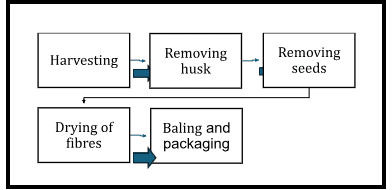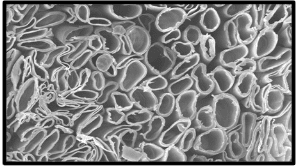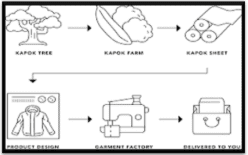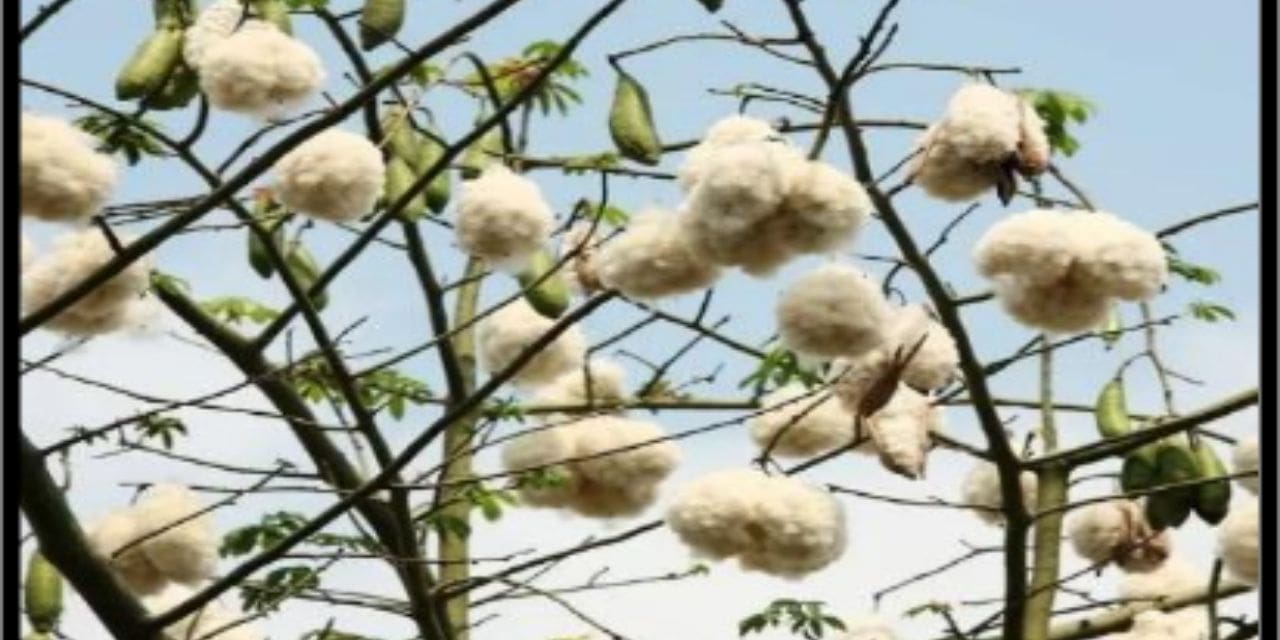1. Botanical Information
- A natural, plant cellulosic fibre, obtained from the seed of the kapok plant.
- The scientific name of kapok is Ceiba Pentandra.
- Also known as silk cotton or java cotton.
- It has a smooth, unicellular, cylindrically shaped, twistless fibre.
- Mostly found in Africa and Central America, it was transported to Asia where it was cultivated to get kapok fibres.
- Kapok is a fibrous material classified along with cotton, as plant hairs or seed fibres, unicellular fibres that develop on the inside of fruit bags.
- Kapok trees can reach up to 30m in cultivation.
- Kapok is a fast-growing tree and becomes productive within 4-5 years.
- It is grown in many tropical countries for its silky fibres, also known as floss.
- The floss is soft, elastic, water-repellent and buoyant.
- They are used to fill pillows, cushions, mattresses, sleeping bags, and life jackets during the early to mid-20th century.
- Family Name: Malvaceae. Common Name: Kapok Tree, Sik Cotton Tree, White Silk Cotton Tree, Kabu-Kabu. Name: Kapok, Kekabu.
2. Agronomic Conditions and Production of Kapok Fibre
-
- The kapok tree is native to Asia, Africa, and South America, and is cultivated for its use in fibre, oil, and timber industries.
- Every Tree gives 15 to 18 kg of fibres and about 30 kg of seeds.
- Under favourable conditions, a tree can produce 330-400 fruits per year thus gaining 15-18 kg fibres per year.
- The fibre yield is about 450 kg/ha.
- Regions with tropical or subtropical climates are the preferred places to grow the kapok tree. The ideal environmental conditions for the cultivation of Kapok trees is 60-80% relative humidity (RH) is ideal for kapok tree health and comfort.
- These trees particularly grow at an altitude which is less than 1000 feet from the sea level.
- The kapok tree requires porous volcanic soil, which has good drainage.
- The fruits of the kapok tree are harvested during the months of June and at the beginning of July.
- These are the tallest types of tropical tree, which can grow up to 230 feet (70m).
- Due to its fast growth, it is used for reforestation.
- The fruits of the tree which carry the kapok fibres are ellipsoid-shaped or capsule/pod.
- This raw material present inside the pod is light, fluffy, lustrous, and light yellow to light brown in colour.
3. Varieties of Kapok Trees
There are four commercially important varieties of Kapok trees viz; Var. caribaea, Var. guineensis, Var. pentandra and Var. indica (DC) Bakh producing fibres of high quality. Kapok tree Var. pentandra is a natural hybrid between Var. caribaea and Var. guineensis.
4. Harvesting and Spinning of Kapok fibres
4.1 Traditional Technique
The bamboo pole is used to harvest the Kapok pods. The separating process was initially executed by drying the pod for approximately 3 to 4 hours and then followed by extracting the fibre from the pod. Next, remove the seeds from the fibre using hands before storing the separated fibre in the container. The duration of extracting fibre is about 5 to 10 minutes for one pod involving 2 to 3 labourers depending on the size of the pod. The environmental condition of the working area is vital which must be free from strong air movement as the fibre may easily be flown away. A mask should be worn for health safety precautions. No other methods used to separate the seeds owing to the high cost to afford. The traditional method has been practised by the local people for a small quantity of production under the cottage industry.
There are three types of Traditional methods for separating seeds from kapok pods which are by bare hands, wooden bamboo stick, and drill on the following considerations.
- Harvesting of the Kapok pod is considered a labour-intensive and strenuous process.
- Collect the extracted kapok fibre from the seedpod in a larger container or strainer.
- Isolate the kapok fibres using a bamboo stick or wood that has been twisted to separate the seeds.
- In the second type, a drill is used to twist the stick to separate the fibres and seeds followed by shaking of the container, so that the kapok seeds fall on the floor.
- Picking up the seeds by hand directly from the kapok obtained from the seed pod is the third type.
The duration of harvesting is about 5 to 10 minutes for one pod involving 2 to 3 labourers, depending on the size of the pod. To maintain time management, labour-intensive work, longer processing time, and low output, machines have been developed for separating the fibres.
4.2 Morden Method
Modern methods of extraction of Kapok are to reduce the labour cost and time. The following set-up is employed in the modern extraction technique. In addition, due to health issues related to traditional methods, innovation to develop modern method which is based on mechanical machines which extract the kapok fibres from the seed pods.
- Operating system -Motorized
- Power source – Electric supply
- Separating Mechanism – mechanical
- Material used– Metal sheet.
- Dimension – 1000mm(h) ×500mm(w) ×800mm(l).
- Weight – 100kg.
- Safety feature -Fully sealed.
As a result, a total of eight different classifications of function were established which include Electric motor, separating mechanism design and position, structure material, frame design, casing style, jointing type and storing compartment design.
 Fig. 2 -Three different design concepts of Kapok fibre seeds separator, (a) concept A, (b) concept B, & (c) concept C.
Fig. 2 -Three different design concepts of Kapok fibre seeds separator, (a) concept A, (b) concept B, & (c) concept C.
Concept A
It is built by steel sheets and square-shape bars as its main material and having a general dimension of 600mm (w) x 400mm (h) x 400 mm (l). Vacuum suction pressure is used to separate the seeds from the fibre in which the seeds will be falling down through a series of filters placed parallelly in the chamber. The operation is completely automatic with overall estimated weight of the device is 7 kg.
Concept B
It focuses on the use of plastic and steel bars for the body and frame, respectively. The device is 1000 mm in height, 500 mm in width, 500 mm in length, and 3 kg in weight. It has semi-automatic operation with a support of battery. A rotating vertical barrel completed with filters is suggested for the separation purpose.
Concept C
It is represented by a vertical chamber that is made of aluminium with an approximate weight of 5 kg. The dimension of the device is 800 (h) x 400 (w) x 500 mm (l), and it is semi-automatic. The seeds are separated from the fibre by a rotating motion of a rod shaft that is attached to the blades. Through screening and scoring evaluations, concept C recorded the highest score, and it is selected for further modifications.
Some significant revisions were imposed on concept C to improve its features. The enhanced concept was further transformed into a three-dimensional (3-D) model using a computer-aided design (CAD) software, Solid Works. As a result, the final design comprises the following eight major parts material specifications.
- frame structure, motor, seeds chamber, front cover, back cover, chamber door, filters, and separating blades.
- Aluminium has been chosen as the main material that constitutes chamber and body casing (front and back covers), whilst other parts such as frame structure, blades, and filters are made of mild steel.
- The Kapok fibres are loaded into the machine through a protruded vertical open channel. The motor-operated blades will rotate and separate the fibre from the seeds. Then, the extracted seeds are filtered and directed into a chamber at the bottom side and the fibres are ready to be collected. The machine is 780, 420, and 335 mm in the length, width, and height, respectively.

Fig. 3 -(a) Three-dimensional model of Kapok fibre seeds separator. (b) Exploded view of the 3-D model. (c) The prototype of product without finishing look (https://www.researchgate.net/publication/342850134_Mechanical_Design_and_Evaluation_of_Kapok_Fibre_Seeds_Separator)
4.3 Names of Kapok fibre according to some of regional Languages in India
In different Regions, kapok is also called “cotton silk”, “samauma”, “java cotton” or “java kapok.”
| Indian Languages | Names |
| Hindi | (semal ki Rui) सेमल की रुई |
| Tamil | (ilavam panju) இலவம் பஞ்சு |
| Telugu | Moggu మొగ్గ |
| Kannada | Mogga ಮೊಗ್ಗಾ |
| Malayalam | Siimappuula ശീമപ്പൂള |
| Marathi | Moggu मोग्गू |
| Bengali | Gadi গাদি |
5. Extraction of Kapok Fibres
 Fig.4: Flow chart of the extraction process of kapok fibre
Fig.4: Flow chart of the extraction process of kapok fibre
- Harvesting is done when the fruit is ripened. The pods are gathered when they fall on the ground, or they can be cut/collected mechanically/manually from the tree. Seed Pods are harvested by hand and closed seed pods are beaten with bamboo sticks to break hard husk and to reach fibres. When ripened, seed pods burst, and the compressed fibres spread widely.
- Removing husks: Ripened fruits are dried under the sunlight for removing husks. Fibres and seeds can be removed from the ponds by hand.
- Removing seeds: The seed and fibre are stored in the basket or simple, sieve-like. devices similar to drums to separate the fibre from the seed, pod debris, dry leaves, etc. So that the seeds fall to the bottom of the container where they are easily separated.
- Drying of fibre: Kapok fibre is dried under the sun for three to five hours.
- Bale making and packing: kapok fibres are then packed in the form of bales.
6. Kapok fibre Spinning Processes
- Due to the shortness and low density, it can withstand only low tensile and torsional forces, kapok is rarely spun.
- Due to the smooth surface and a high content of waxes, kapok fibres have low cohesivity. For that reason, kapok is always spun in blends with other fibres, mostly cotton and used for filling in mattresses, pillows, upholstery, safety vests, and stuffed toys such as teddy bears, and for insulation purposes in general.
- The fibre blending has been proved difficult, and thus far, no blend ratios above 50% have been reported on an industrial process scale. Kapok fibre base having an average length of at least 10 mm.
- Open-end spinning or ring spinning are the two methods used for spinning the yarns.
6.1 Ring Spinning Method
The steps described outline a detailed process for processing a mixture of Kapok fibres and other fibres to produce yarn.
- Mixed Punch
- Prepare a uniform mixture of Kapok and other fibres for further processing.
- Use a combined punching machine after opening and removing impurities .
- Mix the fibres and create a roll with specific weight and length.
- To illustrate, the technical parameters are as follows:
Technical Parameters
Roll Weight: 11.6 kg.
Weight per Metre: 427 g
Roll Length: 24 metres.
- The first soot
By using the action of several pairs of needle-like teeth, carefully comb the mixed rolls of kapok and other fibres to remove impurities, flock linters, and become fully Shino Mix in.
Technical Parameters
- Predetermined Amount: 20 g / 5 metres
- Total Draft: 106.7 times
- Cylinder Speed: 300 rpm.
- Cylinder and Cover Gauge: 0.25 mm, 0.22 mm, 0.22 mm, 0.22 mm, 0.25 mm.
- Doffer Rotation Speed: 12-13 rpm
- The effect is advantageous in strengthening the separation and converting the fibre smoothly.
- After the first soot, a device for guiding the sliver is installed, which is . advantageous for collecting cotton fluff and becoming a scabbard.
- Shinomaki
It is a process to prepare for the second soot.
Technical Parameter
Predetermined Small Roll Amount: 50 g / 5 metres.
- Second Soot
- Further clean and mix the fibres and also removing any remaining impurities.
- Similar to the first soot but applied again for thorough cleaning.
Technical Parameters
- Predetermined Amount: 20 g / 5 metres
- Total Draft: 106.7 times
- Cylinder Speed: 300 rpm.
- Cylinder and Cover Gauge: 0.25 mm, 0.22 mm, 0.22 mm, 0.22 mm, 0.25 mm.
- Doffer Rotation Speed: 12-13 rpm
- First Nerinoshino
- Improve fibre uniformity, mix fibres thoroughly, and enhance elongation parallelism.
- Adjust gauge, increase pressure, and reduce speed.
Technical Parameters:
Front Roller Speed: 700 rpm
1. Second Nerinoshino
- Further improve fibre uniformity and parallelism, similar to the first Nerinoshino step.
Technical Parameters:
Front Roller Speed: 700 rpm
2. Rough Spinning
- Increase fibre separation and elongation, reduce sliver amount, and prepare for fine spinning.
Technical Parameters:
- Specified Amount: 5 g / 10 metres
- Total Draft Multiple: 7.2 times
- Rear Draft Multiple: 1.2 times
- Front Roller Speed: 105 rpm
- Roller Gauge: 13 × 19 × 24.5 mm
- Twist Coefficient: 112
- Fine Spinning
- After stretching a thick sliver by fine spinning, twist it and wind it into a shape. The principle of technology shortens the gauge and has a strong twist.
Technical Parameters:
- Roller Gauge: 13 × 30 mm
- Twist Factor: 340
- Rear Draft Multiple: 1.15
- Technique: Uses a double short apron drafting system and nose bar support to enhance yarn surface quality.
- Winding Yarn
Remove defects and wind the yarn into a cylinder.
- Yarn Count Range: 9.7 Tex to 58.3 Tex (equivalent to 60 S to 10 S)
This sequence of steps ensures that the fibres are processed into high-quality yarn by meticulously cleaning, mixing, spinning, and winding them. The parameters provided guide each stage to achieve the desired fibre characteristics and yarn quality. This study was done by (Ensheng Li, Longquan Xia (2006)).
6.2 Advanced Spinning Techniques
According to the paper published by J. Yan, G. Xu and F. Wang (2011) the new technique of yarn manufacture is discussed. The study selected 18 blended yarns with kapok fibre and other fibres which were manufactured by different spinning technologies, to explore the most efficient spinning yarn technology of kapok fibre. Four properties of these blended yarns were tested including the fineness, unevenness, breaking tenacity, yarn defects and hairiness. According to the standards USTER STATISTICS-2007, GB-T/398-2008 and FZ12001- 1992, the analytical results of four properties have shown that the quality of kapok blended yarn get a better level with the improved spinning technology namely the compact and IV spinning technology. Based on the studies, it is demonstrated that the optimal way to spin kapok blended yarn with high quality, which supplies a support of widening the application of kapok fibres in various product development.
7. Features of Kapok Fibre
- The kapok fibres are 10 to 35mm (3/8 to 1 3/8 in) in length.
- They are fibres with high lignification and are only spinnable when blended with other fibres. Usually, cotton fibre is used for blending.
- These fibres are water- repellent (hydrophobic) and have good thermal insulation properties.
- It is an organic & biodegradable seed fibres and is naturally buoyant.
- Kapok fibres are thus about 5 times lighter than cotton, 4.5 times lighter than polyester, this is due to low in density, and are among the finest naturally occurring microfibres.
- It consists of waxy on the fibre surface and dries quickly if the get wet.
- These fibres are antibacterial, nontoxic, antiallergic, odourless, and rot resistant.
- Kapok yarn was used for fleeces and ribbons to which it imparted a typical lustre.
- Kapok fibre shows a homogeneous circular cross section with wide air-filled lumen having wall thickness of about 1-2 µm.
- Its cell wall is thin and covered with a thick layer of wax.
- The cross section of fibres is oval to round.

Fig. 5: Microscopic structure of kapok fibre, Microphotograph taken with a Scanning Electron Microscope – Transverse cross-sectional view of kapok fibres.
8.Chemical Composition of kapok fibre
The chemical composition of the kapok fibres is as follows:
| Cellulose | Hemi-cellulose | Pectin | Lignin | Ash | wax |
| 38 .09 % | 23% | 23% | 13% | 1.05 % | 2.34% |
9. Physical characteristics of kapok fibre
Physical properties of the kapok fibres are as under:
| Fibre | Fineness (Denier) | Tenacity (g/den) | Relative weight | Elongation at break (%) | Fibre colour range |
| Kapok | 2 0.4-0.7 | 1.4-1.74 | – | 2-4 | Ivory white to camel brown |
10. USES
Some of the traditional uses and specially evolved end uses are described below:
 Fig.6 Value Chain of Kapok Fibre
Fig.6 Value Chain of Kapok Fibre
- This fibre is difficult to spin into thread, so it has been commonly used for filling mattresses, pillows, stuffed toys, life jackets because of its low density. However, modern spinning technology is employed to spin good quality yarn of virgin or blended yarn. Yarn thus produced finds application in different applications.
- Manufacture of Life saving equipment
- Construction of thermally insulated and soundproof covers and walls, technical textile (PPEs)
- It is used as a substitute for surgical cotton.
- Boat and yacht furnishing.
- Insulation materials in refrigeration systems.
- The potential use of kapok fibre as a pulp source for paper making is explored , Sodium hydroxide treatment (10% optimum concentration) of the fibre reduced the amount of lignin and increased the yield of the pulp to enhance its suitability in paper manufacture.
- Kapok pulp can be used as additive to commercial softwood pulp for the manufacture of commercial packaging paper due to its light weightiness, high strength, and excellent water-resistant characteristics.
- Kapok fibre is used as bio-reinforcement material to virgin bitumen.
- Due to its structure, kapok fibre (hollow inside and wax coated outside), has ideal properties to be used as a filter to separate oil from water.
- During recent years, kapok, as a recyclable and biodegradable fibre, has become interesting again in Oil filters as new potentials of it use.
- Kapok seeds are also used in animal feed, the crushed seeds are used both as animal feed and for oil production.
- It is used for production of hygroscopic gauze, insulating materials and in
- Upholstery or like floating material in life jackets.
- Removal of various oil derived castes out of water sources.

Fig.7: Use of Kapok fibres as filler
11. Bibliography
-
- Tatjana Rijavec; (2008), “Kapok in technical textiles” Tekstilec, 2008, letn. 51, št. 10–12, str. 319–331
- Justyna Baraniak; Malgor Zata Kania Dobrowols ka .(2023).Multi–purpose Utilization of Kapok Fibre and properties of ceiba pentendra Tree in various Branches of Industry . Journal of Natural fibres. Journal Article . DOI-10.1080/15440478.2023.2192542.
- Muhammad Ikam Ishak1. MU Rosli, SNA Ahmad Termizi, C Y Khor, Muhamad Asrul Abdullah and MAM Nawi;(2020) “Mechanical Design and Evaluation of kapok fibre seeds separator. DOI-10.1088/1757-899×/864/1/012190. IOP Conference series Materials Science and Engineering, 864(1):012190864(1):072190.
- Reygan H. Sangalang, (2021).” Kapok fibre -Structure, Characteristics and Application: A Review”; Oriental J. Chemistry an International Research J.Pure & applied Chemistry. DOI : http://dx.doi.org/10.13005/ojc/370 301.
- M Gobala brishnam, D Saravana, (2018).” Thermal Insulation properties of Kapok / Cotton Blended Non-Woven Fabric”; International J. Engineering and Advanced Technology (IJEAT). ISSN:2249-89 58 .
- Keko Hori. Maxima E. Flavier, Shigenori Kuga Thi Bach Tuyet Lam. Kenji Liyama; (1999) “Excellent oil Absorbent Kapok (ceiba pentandra )(L) Gaertn.)fibre. Fibre structure, chemical characteristics, and application”. The Japan Wood Research Society (2000).
- Vignesh Dhanabalan & Laga S. K.”Kapok Fibre: A Perspective Fibre .Vignesh Dhanabalan” Email:vigneshdhanabalan@hotmail.com
- Muhd Fadhil Nuruddin, Nadzhratul Husna Ahmad Pwad, Azirul Zainal, Syed Ahmad Farhan, Mohd Faris Khamidi(2014). “Effectiveness of kapok fibre (ceiba pentandra ) as roof insulation for residential building in hot climate Australian J. Basic and Applied Sciences .ISSN:1991-8178.
- Abdelmoumin Yahia Zerga and Muhammad Tahir. (2023).” Biobased kapok fibre Nanostructure for Energy and Environment Application: A Critical Review”; Molecules, 27(22),8107. https://doi.org/10.3390/molecules 27228107.
- Someshwar Bhattacharya, Dharmendra Bihola (2019); “Acoustic Properties of Kapok fibre” International J. Engineering and Advanced Technology (IJEAT)ISSN:2249-8958. DOI:10.35940/ijeat A 9688.109119
- J. Yan, G. Xu, F. Wang (2011).” The investigation of kapok blended yarn spinning technology based on the quality of the yarn”. Fiber Society Spring 2011 Proceedings of the Conference pp 245-246.
- Patent entitled “Method for producing blended yarns of kapoks by ring spinning” Application JP2006352828A events; 2006-12-27,Application Filed By Shinghai Risoo Technology Text, Shinghai Risoo Technology Textile Co Ltd, 2007-12-27, Publication of JP2007332526A

